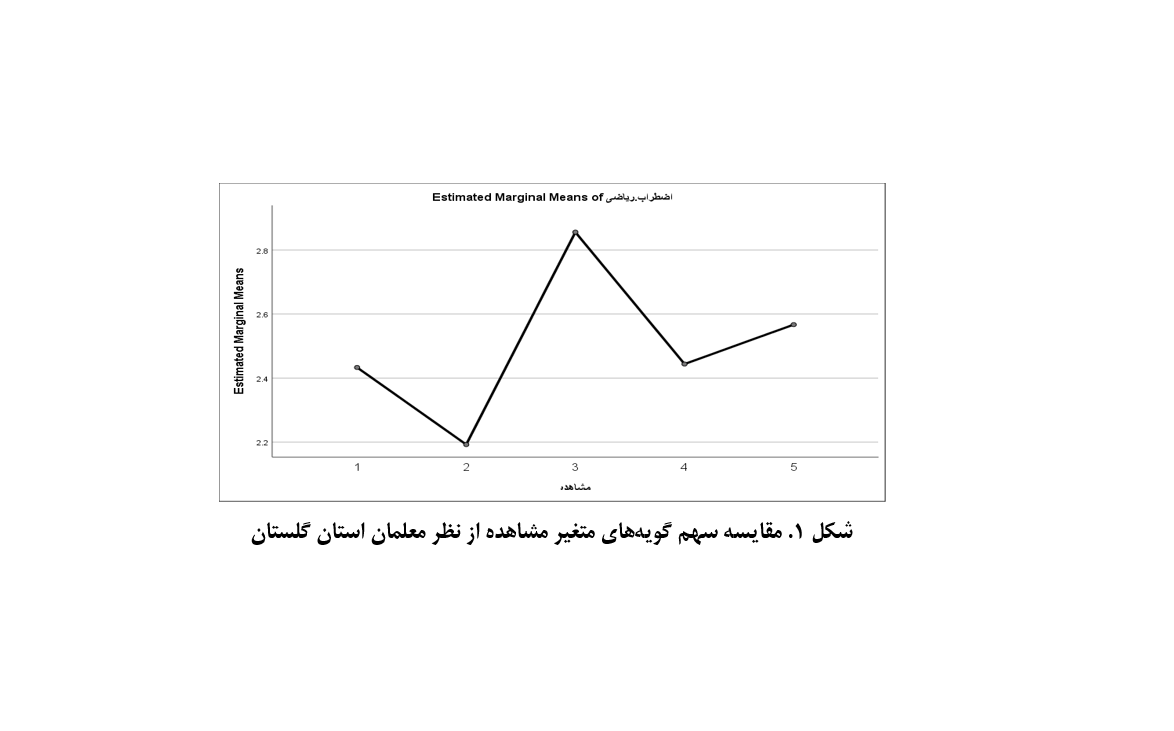Assessment of Teachers' Awareness in Golestan Province about the Signs and Causes of Math Anxiety in Students
Keywords:
Teachers, students, math anxiety, elementary, secondaryAbstract
The present study aimed to assess the level of awareness of teachers in Golestan province regarding the signs and causes of math anxiety in students. This research examines the impact of teachers' self-awareness on their understanding of the causes and factors of math anxiety in their students, as well as the influence of sociological variables, including gender, teaching experience, educational qualifications, teaching location, teacher status, and teaching level, on the extent of this awareness. The research method was descriptive, specifically a survey. The statistical population for this study consisted of all teachers in Golestan province who were in service during the academic year 2024-2025. A cluster sampling method was used to select a sample of 187 participants for the study. The validity of the questionnaire was confirmed by experts in the field of mathematics education, and its reliability was determined using Cronbach's alpha coefficient: 0.86 for the 18 five-point scale questions and 0.79 for the 18 four-point scale questions. Data analysis was performed using SPSS26 software, with descriptive statistics (frequency percentage, mean, and standard deviation) and inferential statistics. The findings of the study revealed that the level of awareness of teachers in Golestan province regarding the signs and causes of math anxiety in students, with a mean score of 2.85 and a significance level of 0.000, was higher than the theoretical mean of the population (2.75). Additionally, significant differences were observed in the means of groups related to the variables of teaching experience, teaching level, and educational qualifications, with significance levels of 0.049, 0.000, and 0.003, respectively. According to the teachers, math anxiety exists in the classroom, and teachers' anxiety does not play a role in creating it in students. Moreover, parents' math anxiety has a significant impact on their children's math anxiety. Furthermore, there is a weak but significant correlation between the "teachers' self-awareness of math anxiety" scale and the "teachers' responses to their knowledge about the signs of anxiety in students" scale (p = 0.03, r = 0.151). However, no relationship was found between teachers' self-awareness and their observations of math anxiety or their responses to the causes of anxiety in students.
Downloads
References
Falco LD, Summers JJ. Social Persuasions in Math and Their Prediction of STEM Course Self-Efficacy in Middle
School. The Journal of Experimental Education. 2021;89(2):326-43. doi: 10.1080/00220973.2019.1681350.
Cresswell C, Speelman CP. Does Mathematics Training Lead to Better Logical Thinking and Reasoning? A CrossSectional Assessment from Students to Professors. PLOS One. 2020;15(7):e0236153. doi: 10.1371/journal.pone.0236153.
Scheibe DA, Was CA, Dunlosky J, Thompson CA. Metacognitive Cues, Working Memory, and Math Anxiety: The
Regulated Attention in Mathematical Problem Solving (RAMPS) Framework. Journal of Intelligence. 2023;11(6):117. doi:
3390/jintelligence11060117.
Fennema E, Sherman JA. Fennema-Sherman Mathematics Attitudes Scales: Instruments Designed to Measure
Attitudes Toward the Learning of Mathematics by Females and Males. Journal for Research in Mathematics Education.
;7(5):324-6. doi: 10.5951/jresematheduc.7.5.0324.
Manapa I. Mathematics Anxiety Level of Pre-Service Elementary School Teachers During Online Learning in the
COVID-19 Pandemic. Journal of Mathematics Education (Medives). 2021;5:339-52. doi: 10.31331/medivesveteran.v5i2.1720.
Copur-Gencturk Y, Thacker I, Cimpian JR. Teachers' Race and Gender Biases and the Moderating Effects of Their
Beliefs and Dispositions. International Journal of STEM Education. 2023;10(1):31.
Escalera-Chávez M, Moreno-García E, García-Santillán A, Córdova-Rangel A. Factors that Promote the Level of
Anxiety Towards Mathematics in Upper Middle-Level Students in the Rioverde San Luis Potosí Region. European Journal of
Education Studies. 2016;2:8-22.
Pekrun R. The Control-Value Theory of Achievement Emotions: Assumptions, Corollaries, and Implications for
Educational Research and Practice. Educational Psychology Review. 2006;18:315-41. doi: 10.1007/s10648-006-9029-9.
BaoGuo AN, KahHeng CH. Emotional Status of Malaysian Teachers on Online Teaching During the COVID-19
Pandemic. Turkish Journal of Computer and Mathematics Education (TURCOMAT). 2021;12(14):5104-14.
Huyen L, Ngo T, Nguyen T, Thanh T, Bao T, Vinh LT. An Investigation of Mathematics Anxiety and Academic
Coping Strategies Among High School Students in Vietnam: A Cross-Sectional Study. Frontiers in Education. 2021;6:742130.
Jafari F, Mousavi F, Emamipour S. The Role of Perfectionism and Achievement Goals in Predicting Test Anxiety
Among First-Year Female Middle School Students. Educational and Learning Research. 2015;12(2):65-78.
Sasanguie D, Larmuseau C, Depaepe F, Jansen BR. Anxiety About Mathematics and Reading in Preadolescents Is
Domain-Specific. Journal of Intelligence. 2024;12(2):14. doi: 10.3390/jintelligence12020014.
Hosseini M, Tehranian A, Behzadi MH, Alem al-Hoda SH. Examining the Relationship Between Teachers' Skills in
Qualitative Evaluation of Mathematics, Math Anxiety, Academic Procrastination, and Students' Thinking Styles. Mashhad
University of Medical Sciences Journal. 2022;65(2):870-84.
Willis R, Lynch D, Peddell L, Zehntner C, Bruck P. Get on the Cycle of Engagement with Mathematics: Re-imagining
a Model and a Three-Step Process for Primary/Secondary Teachers. Re-imagining Teaching Improvement: From Early
Childhood to University2024. p. 131-901.
Su X, Guo Z. An Analysis of the Effect of Teachers' Behavior on Mathematics Anxiety and the Role of Intervention
Programs. 2022.
Szczygieł M. More Evidence That Math Anxiety Is Specific to Math in Young Children: The Correlates of the Math
Anxiety Questionnaire for Children (MAQC). International Electronic Journal of Elementary Education. 2020;12(5):429-38.
doi: 10.26822/iejee.2020562133.
Polacco D, Luliana M, Dekel R. Perspectives of Teachers on the Signs and Causes of Mathematics Anxiety. Acta
Didactica Napocensia. 2023;16(2):126-43.
Hembree R. The Nature, Effects, and Relief of Mathematics Anxiety. Journal for Research in Mathematics Education.
;21(1):33-46. doi: 10.5951/jresematheduc.21.1.0033.
Ayuso N, Fillola E, Masiá B, Murillo AC, Trillo-Lado R, Baldassarri S, et al. Gender Gap in STEM: A Cross-Sectional
Study of Primary School Students' Self-Perception and Test Anxiety in Mathematics. IEEE Transactions on Education.
;64(1):40-9. doi: 10.1109/TE.2020.3004075.

Downloads
Published
Submitted
Revised
Accepted
Issue
Section
License
Copyright (c) 2024 Journal of Study and Innovation in Education and Development

This work is licensed under a Creative Commons Attribution-NonCommercial 4.0 International License.










